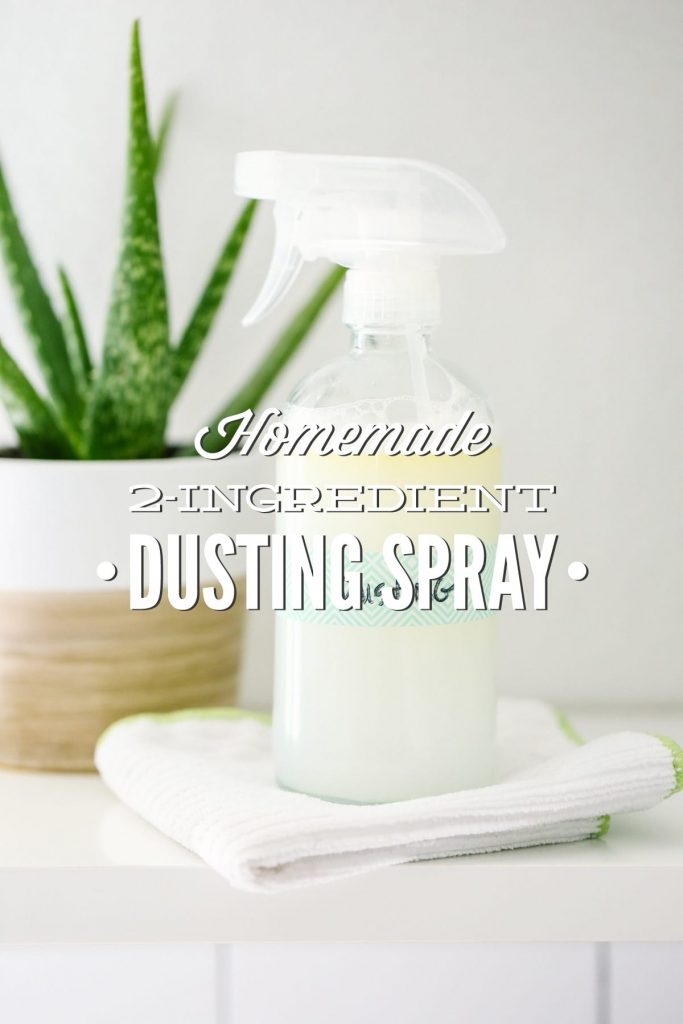
Want to Save This Article?
Enter your email & I’ll send it straight to your inbox. And you’ll get new recipes & tips each week.
When it comes to describing a dusting spray, the last thing most people think about is the phrase two-ingredient.
In fact, just trying to learn about the exact ingredients used in commercial dusting sprays has proved to be a very difficult task. No, more like an impossible task. Considering the fact that I’ve only been able to learn about a few of the disclosed ingredients in the most popular dusting spray sold in stores, I believe it’s safe to say that a two-ingredient dusting spray is quite a revolutionary idea.
Since when did dusting furniture become so complicated and toxic?
Instead of focusing on the negative, the multi-ingredient and ultra-mysterious dusting sprays, let’s focus our discussion on a dusting spray that’s made with just two ingredients. And most importantly, a dusting spray that we can feel confident about safely using in our homes and around our families. I know, such a simple dusting spray sounds too good to be true, right?! It exists, friend, it exists!!
First, I think it’s important to revisit the purpose of dusting spray. After all, if we’re going to spend our time making and using a cleaner, it needs to be a necessary product, not just something marketers have led us to believe we need.
Simply stated, a dusting spray is used to trap dust and other allergens, making it easier to pick up the unwelcome guests with a cloth or duster. Many times, commercial dusting sprays are used to shine and polish wood surfaces; however, I believe wood just needs a light dusting versus heavy-duty polishing most of the time. Every couple of months, I use a homemade wood polish on our wood furniture. If you own the DIY Natural Cleaning Challenge, the recipe is on page 166.
I propose that a cleaning tool with such a simple and important purpose should also be made with simple ingredients. That only seems like common sense, right?!
With this purpose in mind, let’s take a look at the two ingredients used to make my homemade dusting spray:
Castile Soap: According to Time Magazine, “Dust consists of some combination of shed bits of human skin, animal fur, decomposing insects, food debris, lint and organic fibers from clothes, bedding and other fabrics, tracked-in soil, soot, particulate matter from smoking and cooking, and, disturbingly, lead, arsenic and even DDT.” Yuck! In the natural cleaning world, castile soap is the super hero ingredient that fights against the multi-faceted villain known as DUST.
Castile soap is a concentrated vegetable-based soap made of ingredients you can actually pronounce. This soap is gentle on the skin and effective in the fight against dirt, grease, dust, and unwanted germs. Dr. Bronner’s is a very a popular brand of castile soap. Castile soap can be used to clean just about anything and everything: your face, your laundry, and even your stinky dog!
Water: In my homemade dusting spray, good ol’ water aids in lifting dust and allergens from surfaces. When water is accompanied by castile soap and a microfiber cloth, the dynamic trio is an unstoppable force in the fight against our villain, DUST.
Optional Ingredients: Yes, my homemade dusting spray technically only requires two ingredients, and a microfiber cloth (trust me, try the microfiber cloth!), but there are two other ingredient options worth mentioning: a moisturizing oil (if you’re dusting wood surfaces) and lemon essential oil (for scent and beneficial cleaning properties).
Let’s start an alternative cleaning revolution, and get back to using simple, two-ingredient formulas that are safe and effective. Ready, set, go!
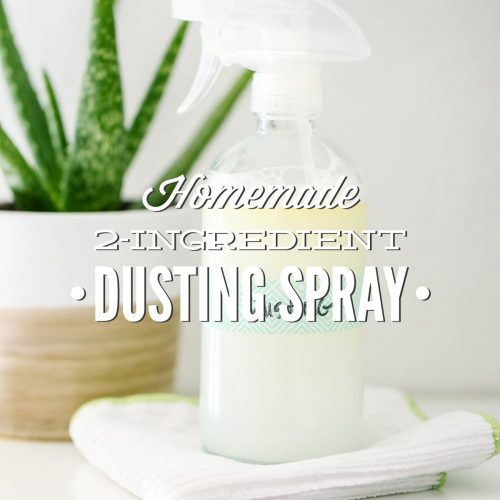
Homemade 2-Ingredient Dusting Spray
Ingredients
- 1 cup distilled water
- 2 tsp castile soap
- 1 TB extra virgin olive oil or jojoba oil, optional
- 3 drops lemon essential oil optional
Instructions
- Combine the water, liquid castile soap, moisturizing oil, and lemon essential oil in a spray bottle. Gently shake the bottle to combine the ingredients.
- To Use: Spray a cloth (microfiber is preferable) with dusting spray, then wipe surfaces to remove dust. If you added oil to the formula, you'll need to gently shake the bottle before spraying the cloth. This may not be safe for all wood surfaces. It’s important to know how your wood has been sealed before using any cleaning product.

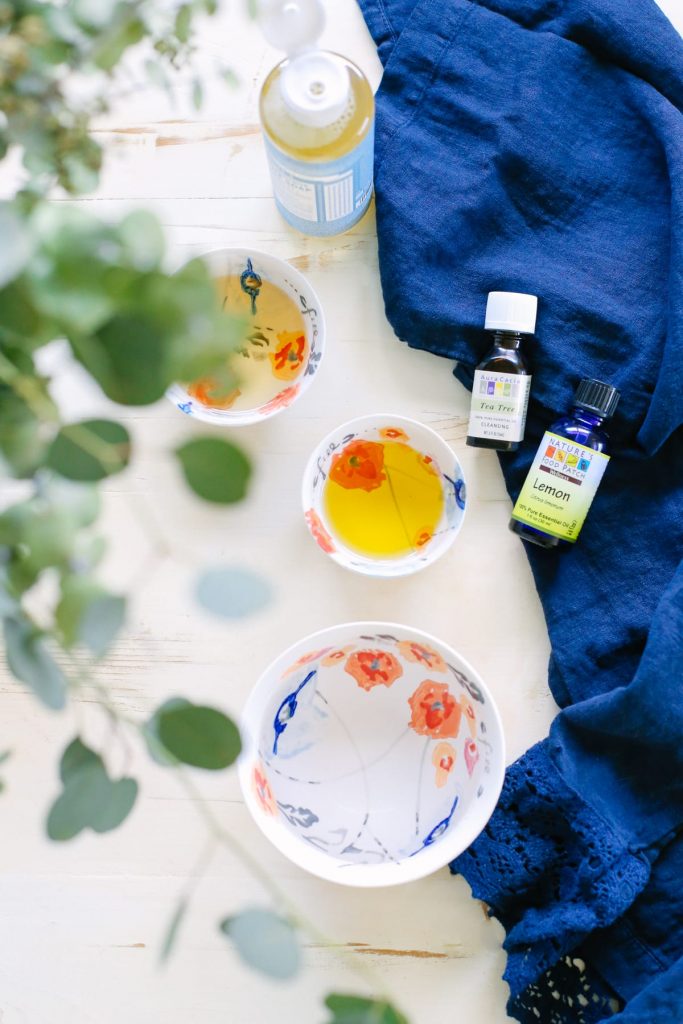
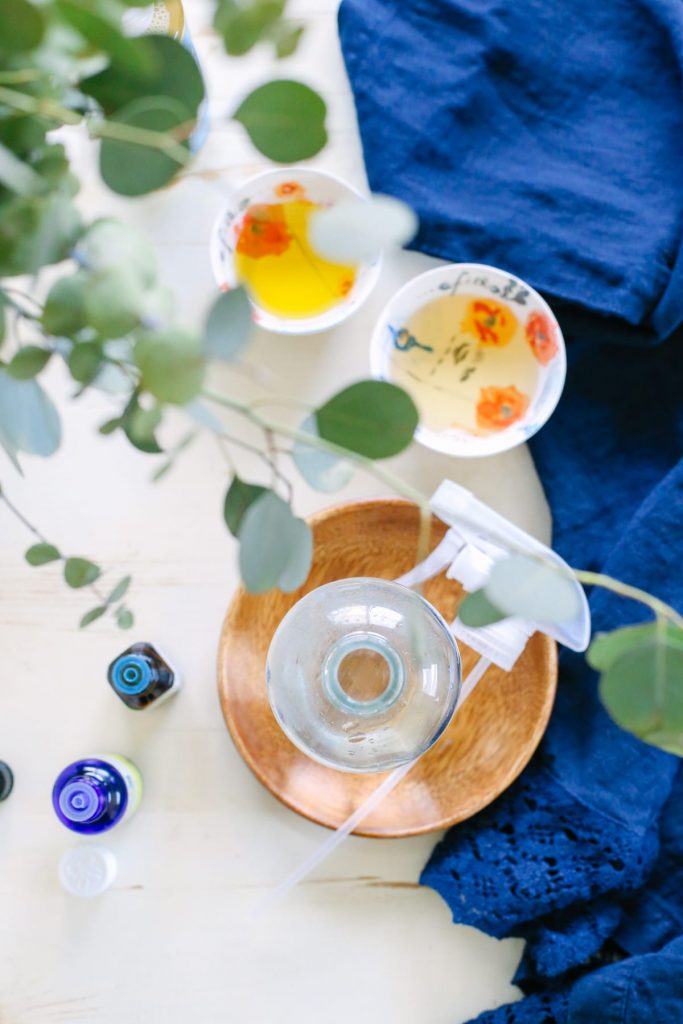
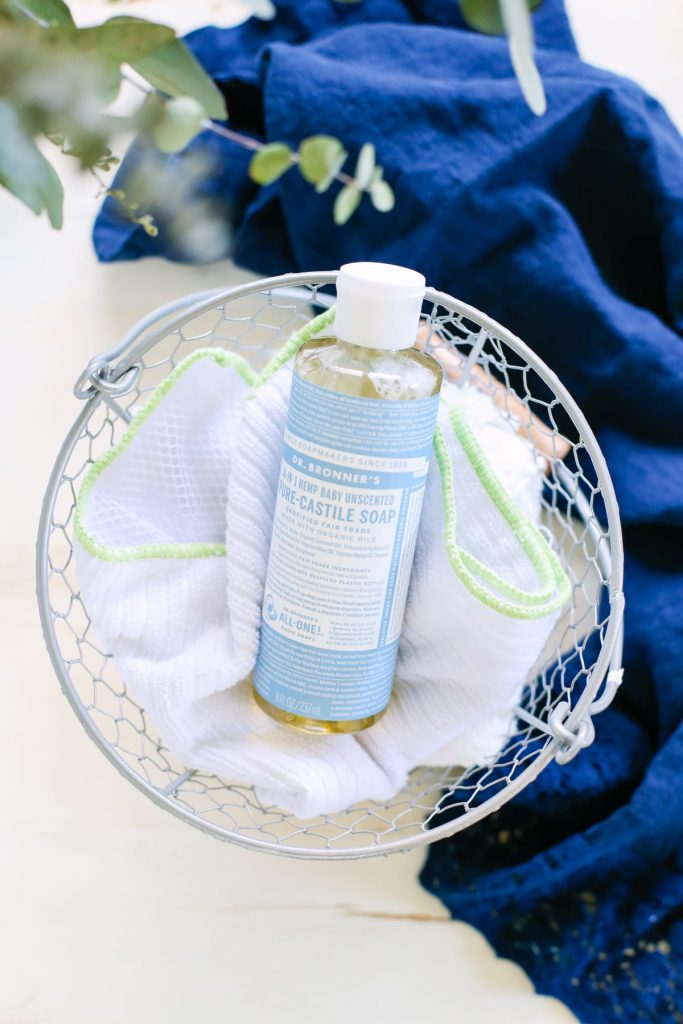
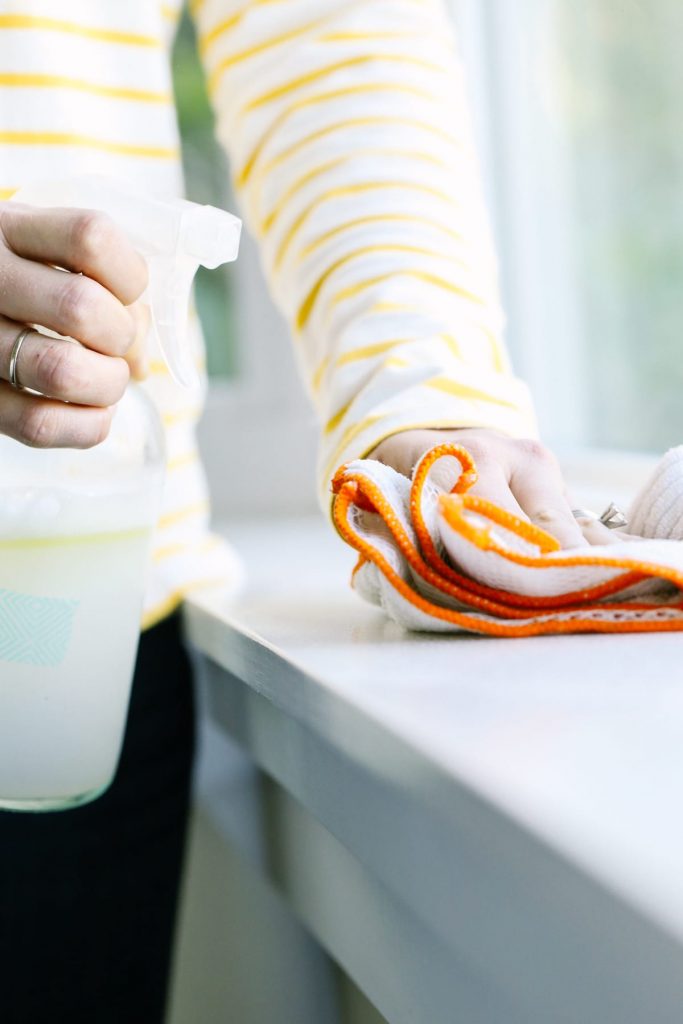

Not sure about the name dusting spray… dust attracts to oils & water so is it more like a ALL purpose cleaner…
You’re welcome to use it how you’d like, Carla :).
Hello, Jennifer. This is a dusting spray, not a wood polisher, for removing dust and dirt debris. For that, I’ve found that a combination of oil and beeswax works great.
This is so effective for stainless steel appliances! Made them look clean and shine better than anything I’ve used prior! Thanks!
Yay, Haley! So happy to hear that.
Is it possible to make a floor dusting spray without oil in it? The oil makes hard to clean it. I’m looking for the old time –dusting spray and a dust mop; but doesn’t leave a film. I can remember sitting (riding) on mom’s dust mop while she shined her floors. That kinda tells my age huh?
A floor cleaner? I’m not sure what kind of floor it is, but I would use this recipe: https://livesimply.me/2015/11/16/how-to-make-homemade-floor-cleaner-2-ways/.
First I want to say I appreciate the recipe and everything it stands for. I made it and tried it on several different types of wood.. unfinished, antique, and finished like Broyhill.. My experience with it was it can replace Murphy’s Oil Soap. I was looking for something to replace Pledge. This certainly did clean all my wood but it really didn’t make anything shine like Pledge does. I have been replacing my commercial cleaning products with safe diy products but am still searching for something to “polish” my wood furniture. Should I add more olive oil? I don’t want the furniture to look or feel oily by any means… I just feel like my furniture looks like I just cleaned it with Murphy’s Oil Soap… I really don’t want to go back to Pledge. Please advise.
Hey Jennifer, This is a dusting spray for cleaning off dust and dirt debris, not a wood polisher. For that, a combo of an oil and beeswax have worked well for me. I have a recipe in my cleaning book. If you email me with the request, I’ll get that particular recipe over your way. There are a bunch online too. This recipe may be more of what you’re looking for–a polish versus a dusting spray: https://housewifehowtos.com/clean/homemade-furniture-polish/ It doen’t use beeswax.
Is this okay to use on wood trim, windows, etc that have a poly coat?
Hey CS, I would test a very small area first. I personally have used it successfully on such finishes.
In the spirit of natural cleaning wouldn’t a genuine chamois be preferable to a synthetic microfiber cloth? Not only do they contribute to plastic pollution, but there are greater environmental concerns about microfiber cloths entering the oceanic food chain similar to other microplastics. Microfibers account for 85% of man-made debris found on shorelines worldwide
Thank you for the information, Paul. I’ll definitely look into this. I haven’t heard of a genuine chamois before.
I was just about to ask if anyone knew any alternatives to microfiber. I used to adore microfiber clothes before I knew about the plastics issue. I’ve read about using flannel and old t-shirts, and I use both, but I’m glad to know about genuine chamois and will be looking into getting some. Thanks, Paul!
Hey Sue, I would use the material cloth you feel most comfortable using and also gets the job done.
Can i use a preservative such as optiphen to preserve if i want to sell it
Hi Latonya,
Kristin is currently out of the country, but I’ll make sure to let her know of your comment so she can respond when she returns. ~Rachel
Hey Latonya, I don’t know anything about selling products like this safely. Sorry.
I made this homemade spray and not added the lemon oil but also peppermint oil. It smells great. What I would like to know is if it would be safe to spray on my couches and area rug? My dogs brought in some fleas and I know they don’t like the smell of citrus so I would like to spray these items down.
I have to ask, where do you find your spray bottles and do they leak? I have had a heck of a time trying to find good spray bottles and yours look pretty good.
Hey Natasha, I’ve been using Sally’s Oragnics for years. The bottles are excellent: http://amzn.to/2DBRpMM
found this after searching for homemade polish and cleaners as the store bought polish always left me with a headache afetrwards. A couple of questions though. 1. Is there anythngt o avoid using this on if i add oil of some kinde. EG Cleaning tv screen or picture frames and glass , would they become streaky or smeared with the oil and 2. if they do become streaky with the oil, would they be streaky without oil and using just castile soap?
Can I use coconut oil instead of olive oil?
Hi Heidi, Kristin is on vacation right now, but I have made a note for her to answer your comment when she returns. Rachel
Hey Heidi, It will need to be fractionated coconut oil.
Where do you find decent, reasonably priced spray bottles that don’t stop working after a single use?
Hey Jennifer, I use Sally’s Organics from Amazon. I’ve used the same bottles for a couple of years now, without issue.
Thank you thank you thank you. This is very useful and I am going to try this over the weekend.
Thank you kindly for this recipe!
I’ve just noticed that when not being used my spray seems to separate into translucent liquid and then some murky-cloudiness, but then when I shake it up, it all becomes a generally cloudy mixture.
Is this normal? I made it with filtered water, and I remember that castile soap shouldn’t become cloudy in soft water. Is it the olive oil or the lemon essential oil that is doing it?
Hey Martin, Yes, this is normal for recipes that don’t contain any kind of emulsifier (an ingredient used to blend oil and water products together).
I also added 3 drops each of frankincense & myre essential oils. This stuff is great! I’m taking the 409 et. al. cleaners and furniture dusters permanently off my shopping list. One general cleaner/duster replaces all of those bottles in the pantry. I’m Happy that I discovered this recipe!
That’s so great, Les! Congrats!
Were do you get the labels? I use canning labels, But they dissolve if you touch them with wet hands…
Hey Grace, I usually look in the Target dollar bins or Michael’s Craft Store. I also love to use Washi tape and a marker.
Okay, thanks so much!
Hi Kristin! I’ve found a few dust sprays that have either vinegar or castile soap in them. You can’t combine both though, can you?
Hey Leah, I wish it was possible, but castile soap and vinegar don’t get along :(. Here’s more information: https://livesimply.me/2015/11/18/4-natural-cleaning-ingredients-to-avoid-combining/. If you’re primarily dusting non-wood furniture, vinegar is awesome (I’ll be sharing my version of this dusting spray in a couple of weeks), but if you’re working with a lot of wood, I prefer to stick with castile soap as the “main” ingredient.
I am surprised you did not add vinegar, as it prevents dust from coning back too fast 🙂
works well – tested and approved!
have a nice weekend
Hey Pretty Arty, Vinegar is definitely a great option. Some wood surfaces don’t hold up well with a vinegar cleaner, so I like to use a neutral ingredient like castile soap just to be cautious.
Vinegar will cause castile soap to partially solidify, kind of like curdling.
I stick to the two main ingredients, soap and water, because the same bottle of cleaner is great on kitchen counters for the nightly wipedown..
Hey Dnogero, Yes, thanks for pointing this out! I’m sorry if the way I phrased that was confusing. I was referring to just using vinegar and water to make a dusting spray.
Hi Kristen! I am wondering if I could use Doctor Bronner’s sal’s suds instead of the castle soap for this recipe, since it can be combined with vinegar. I use it for a lot of my other cleaning recipes already and I find it does a great job.
Hey Kim, Definitely! Sal Suds would be fantastic in this recipe. I would just use less of it.